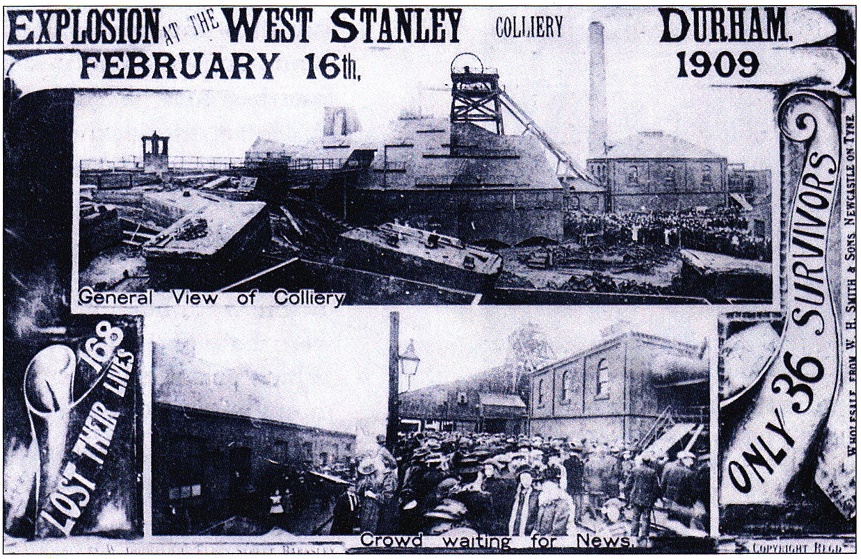
The Death Pit

It was the afternoon of 16 February, 1909, in the mining town of Stanley, in County Durham. At the town's mine, Ralph Stephenson, the engineer, heard a dull rumble. He walked over to the pit mouth and looked down into the shaft.
Burns Pit, named after its owner, had four seams of coal. The Towneley seam was 225 metres underground. Below it were the Tilley and the Busty seams. The Brockwell was the lowest, 300 metres deep. In the Brockwell seam, a pocket of methane gas – called 'firedamp' by the miners – had been ignited by a Howart's safety lamp. There was a small explosion.
Below ground, the miners heard the bang. Richard Proud, aged 14, took cover in a manhole. He knew what would happen next. Through the mine a rush of air whipped up the coal dust . The dust of any combustible matenal – even custard powder – becomes exp
losive when the specks are surrounded by air, and coal dust is especially dangerous.
The Explosion
At the surface, Ralph Stephenson heard the pit growl.
He saw a red glow at the bottom of the shaft. Fifty seconds after the first explosion, the coal dust ignited. A huge fireball rushed up the shaft and burst past Stephenson, rising high into the air,; then, mysteriously, it reversed and sucked the smoke and flames back down into the mine.
Underground, dozens of miners had been killed. Richard Proud was dead. William Chaytor, 55, had also been killed; his watch had stopped at 3.45pm, the time of the explosion. One man's head had been smashed open; they found his brains far away by a pit-prop. A young boy and his pony had been moving tubs of coal when the blast struck. They found his body under the pony; his head was beneath one of the tubs.
Stanley Reacts
Life in the town stopped in its tracks. A terrible wail went up as the women realised what had happened. Then everybody ran to the mine. In the rush, Fitz Armstrong, the son of the local postmaster, was knocked down and killed by a horse-bus.
For hours nothing could be done. The manager was away seeking another job. Rescue equipment had to be fetched from a nearby mine. Nobody knew who was underground, or even how many men were down there.
One weeping girl caught the attention of a kindly miner. "What's the matter, hinny?" he asked. Her mother had died some time before, and her father and two brothers were in the mine. The Reverend Watson knelt with her and prayed and cried.
The Survivors
Some miners had survived both blasts, but explosions are not the end in a mine disaster. After the two explosions, `chokedamp' (carbon monoxide) swept through the mine, suffocating many of the survivors. They lay life-like, their eyes open, their faces flushed pink with the effects of the gas.
Even so, some men were still alive in the Tilley seam, which had avoided the worst of the blast. One of them was Mark Henderson, a deputy. He gathered 36 men together and took them to a small gallery where there was some fresh air left.
There, they waited. Hours passed. Two men panicked and rushed off into the mine. Soon after, seven more followed; they found them later, suffocated by the chokedamp.
Someone began to sing a hymn:
Lead kindly light, amid the encircling gloom,
Lead Thou me on;
The night is dark, and I am far from home,
Lead Thou me on.
The miners joined in. One of them, Bob Harrison, was in the Salvation Army. Yet even as they sang, little Jimmy Garner, 14, his legs crushed, lay back and died.
Henderson realised that he would have to go for help. Covering his mouth against the gases and choking smoke, he made his way along the passages to the only working telephone: "Can you get us out?"
Aftermath
It took 14 hours to rescue the men.
Some good did come from the disaster; mines started to use a system of tallies so they could always know how many men were underground.
But the loss was terrible. Only 30 men survived. One hundred and sixty-eight men died; 60 of them were under the age of 20.
Burns Pit finally closed down in 1936. The people of Stanley hated it. One night, the watchman went over to the old shaft. "Damn you!" he shouted down.
In the emptiness, his voice echoed back to him: "Damn you," replied Burns Pit.

There are no lesson tasks associated with this story, but you will refer to it when you study working down a coal mine in the unit The Curse of Coal – the 1842 Report.
Links:
The following websites will help you research further:
• Index of Mining Disasters – Durham Mining Museum
Interrogating the story:
•
what do you think was the saddest thing in the story? •
what did you find the most arresting fact?
•
use the story to work out the usual sequence of events in a coal mine
explosion
Click here for the answer